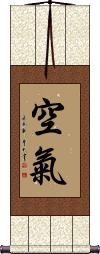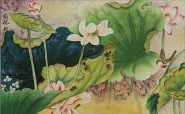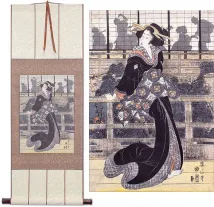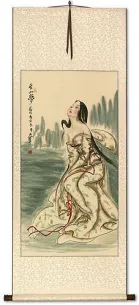Many custom options...
And formats...

Air Atmosphere in Chinese / Japanese...
Buy an Air Atmosphere calligraphy wall scroll here!
Air / Atmosphere
空氣 means air or atmosphere in Chinese, Japanese Kanji, and old Korean Hanja.
This is an unusual title for an Asian calligraphy wall scroll, but many of our western customers have requested it.
![]() While 空氣 is common in Chinese and Korean Hanja (and ancient Japanese Kanji); please note that in modern Japanese, the second character is written as 気, with slightly fewer strokes. If you want the modern Japanese version, please click on the character to the right. Both versions are understood by native Chinese, Japanese, and many (but not all) Korean people. You should choose the appropriate version based on the intended audience for your calligraphy artwork.
While 空氣 is common in Chinese and Korean Hanja (and ancient Japanese Kanji); please note that in modern Japanese, the second character is written as 気, with slightly fewer strokes. If you want the modern Japanese version, please click on the character to the right. Both versions are understood by native Chinese, Japanese, and many (but not all) Korean people. You should choose the appropriate version based on the intended audience for your calligraphy artwork.
This in-stock artwork might be what you are looking for, and ships right away...
Gallery Price: $353.00
Your Price: $195.88
Gallery Price: $108.00
Your Price: $59.88
Gallery Price: $200.00
Your Price: $79.88
Gallery Price: $60.00
Your Price: $39.88
Not the results for Air Atmosphere that you were looking for?
Below are some entries from our dictionary that may match your Air Atmosphere search...
| Characters If shown, 2nd row is Simp. Chinese |
Pronunciation Romanization |
Simple Dictionary Definition |
氣 气 see styles |
qì qi4 ch`i chi ki き |
More info & calligraphy: Life Energy / Spiritual Energy(out-dated kanji) (1) spirit; mind; heart; (2) nature; disposition; (3) motivation; intention; (4) mood; feelings; (5) ambience; atmosphere; mood energy |
空氣 空气 see styles |
kōng qì kong1 qi4 k`ung ch`i kung chi |
More info & calligraphy: Air / Atmosphere |
妖気 see styles |
youki / yoki ようき |
ominous atmosphere; ghostly air; weird air; unearthly atmosphere |
妖氛 see styles |
youfun / yofun ようふん |
(archaism) (See 妖気) ominous air; weird air; menacing atmosphere |
気圧 see styles |
kiatsu きあつ |
(1) atmospheric pressure; air pressure; (2) {physics} atmosphere (unit of pressure) |
氣圈 气圈 see styles |
qì quān qi4 quan1 ch`i ch`üan chi chüan |
(planet) atmosphere; (medical) air ring; air cushion |
海気 see styles |
kaiki かいき |
(1) sea air; sea breeze; (2) ocean and atmosphere; (3) type of yarn-dyed silk goods; (surname) Kaiki |
熱気 see styles |
nekki ねっき |
(1) heat; hot air; (2) enthusiasm; excitement; fervour; fervor; heated atmosphere; (3) fever |
空気 see styles |
kuuki / kuki くうき |
(1) air; atmosphere; (2) (See 空気を読む) mood; situation; (3) (colloquialism) (idiom) someone with no presence; someone who doesn't stand out at all; (female given name) Ea |
高層 高层 see styles |
gāo céng gao1 ceng2 kao ts`eng kao tseng kousou / koso こうそう |
high-rise; high level; high class (adj-no,n) (1) (ant: 低層・1) high-rise (building); multistory; multistoried; tall; (adj-no,n) (2) high (altitude); upper (atmosphere, air current, etc.) |
阿迦奢 see styles |
ā jiā shē a1 jia1 she1 a chia she akasha |
ākāśa, the sky space, the air, ether, atmosphere. |
雰囲気 see styles |
funiki ふんいき fuinki ふいんき |
(1) mood; ambience; ambiance; aura; feel; (2) a certain air; presence; special aura; something (about someone); (3) air; atmosphere; (ik) (1) mood; ambience; ambiance; aura; feel; (2) a certain air; presence; special aura; something (about someone); (3) air; atmosphere |
ふんい気 see styles |
funiki ふんいき |
(1) mood; ambience; ambiance; aura; feel; (2) a certain air; presence; special aura; something (about someone); (3) air; atmosphere |
ふん囲気 see styles |
funiki ふんいき |
(1) mood; ambience; ambiance; aura; feel; (2) a certain air; presence; special aura; something (about someone); (3) air; atmosphere |
自由大気 see styles |
jiyuutaiki / jiyutaiki じゆうたいき |
{met} free atmosphere (part of the atmosphere above the frictional influence of the earth's surface); free air |
高層大気 see styles |
kousoutaiki / kosotaiki こうそうたいき |
upper air; upper atmosphere |
Variations: |
ki き |
(1) (See 気が大きい) spirit; mind; heart; (2) (See 気が短い) nature; disposition; (3) (oft. after a verb) (See やる気,気がない・1) intention; mind; will; motivation; (4) (See 気が変わる,気が重い) mood; feelings; (5) (See 気を失う) consciousness; (6) (See 気を使う) care; attention; consideration; worry; (7) (See 気を引く・1) interest; (8) (the) air; atmosphere; (9) ambience; atmosphere (of); air (of); mood; (10) fragrance; aroma; flavour; taste; (11) qi (in traditional Chinese philosophy and medicine); chi; ki |
Variations: |
taiki たいき |
(1) atmosphere; air; (2) (See 大度) magnanimity; generosity |
Variations: |
taiki たいき |
(1) atmosphere; air; (2) (See 大度) magnanimity; generosity |
Variations: |
kaiki かいき |
(1) (海気 only) sea air; sea breeze; (2) (海気 only) ocean and atmosphere; (3) type of yarn-dyed silk goods |
Variations: |
funiki(p); fuinki(雰囲気)(ik) ふんいき(P); ふいんき(雰囲気)(ik) |
(1) atmosphere; mood; ambience; ambiance; aura; feel; (2) a certain air; presence; special aura; something (about someone); (3) (obsolete) (See 大気・1) (Earth's) atmosphere |
Variations: |
funiki(p); fuinki(ik) ふんいき(P); ふいんき(ik) |
(1) (often spoken as ふいんき) atmosphere; mood; ambience; ambiance; aura; feel; (2) a certain air; presence; special aura; something (about someone); (3) (obsolete) (See 大気・1) (Earth's) atmosphere |
The following table may be helpful for those studying Chinese or Japanese...
| Title | Characters | Romaji (Romanized Japanese) | Various forms of Romanized Chinese | |
| Air Atmosphere | 空氣 空气 / 空気 | kuu ki / kuuki / ku ki | kōng qì / kong1 qi4 / kong qi / kongqi | k`ung ch`i / kungchi / kung chi |
| In some entries above you will see that characters have different versions above and below a line. In these cases, the characters above the line are Traditional Chinese, while the ones below are Simplified Chinese. | ||||
Successful Chinese Character and Japanese Kanji calligraphy searches within the last few hours...








